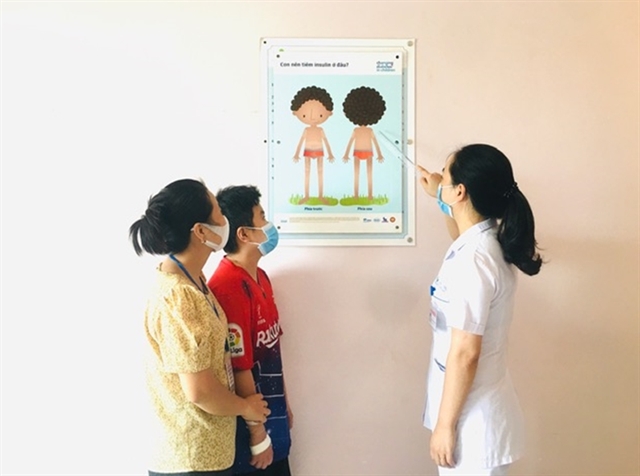 Society
Society

 |
| A doctor guides a parent and her child on how to inject insulin. Photo benhviennhitrunguong.gov.vn |
HÀ NỘI - Type 1 diabetes currently accounts for 90 per cent of diabetes cases in children. In Việt Nam, data from major paediatric hospitals indicate that nearly 2,000 children have been diagnosed with Type 1 diabetes, with the condition showing an increasing trend.
"Diabetes is a global public health threat, including in Việt Nam," said Nguyễn Trọng Khoa, Deputy Director of the Department of Medical Examination and Treatment Management.
"Diabetes causes numerous health complications such as cardiovascular disease, eye problems and nerve damage and is a major cause of kidney failure and other complications. Diabetic patients with complications not only face increased medical costs, but also a reduced quality of life."
Medical expenses for adult diabetes patients account for 12 per cent of global healthcare costs. According to the International Diabetes Federation (IDF), around 537 million adults worldwide were living with diabetes in 2021, a number projected to rise to 783 million by 2045.
According to Khoa, up to half of all diabetes cases remain undiagnosed. Many people live with Type 2 diabetes for an extended period without realising it and by the time they receive a diagnosis, complications have often already set in. However, 70 per cent of Type 2 diabetes cases can be prevented or delayed through healthy lifestyle choices.
Comprehensive epidemiological data on Type 1 diabetes in children is not yet available in Việt Nam. However, data from leading paediatric hospitals indicate an increasing trend over the past seven years, highlighting ongoing challenges in diagnosis and treatment.
Trần Minh Điển, President of the Việt Nam Paediatrics Association and Director of the National Children's Hospital, explained that Type 1 diabetes, also known as insulin-dependent diabetes, can occur at any age, from infancy onwards. Unfortunately, some cases were only detected when the patient was in a critical condition, such as a coma or diabetic ketoacidosis.
“The causes of Type 1 diabetes are linked to various factors such as genetic susceptibility, environmental influences, the immune system and β-cell function. However, the specific roles of these factors are still unclear. Patients with Type 1 diabetes require initial insulin treatment in the hospital, followed by stable dose management at home. The focus should be on monitoring and appropriate treatment to minimise complications," Điển said.
Previously, the National Children's Hospital managed only 10-15 cases of Type 1 diabetes annually. However, in recent years, the number of cases has rapidly increased, with hundreds of children now receiving treatment each year. The hospital currently manages about 200-300 children with Type 1 diabetes who regularly attend for check-ups and treatment.
Điển highlighted that if only a few major hospitals, such as the National Children's Hospital, Children's Hospital 1, and Huế Central Hospital, managed these patients, it would be challenging due to the limited number of paediatricians specialising in diabetes. He suggested expanding the management network to more healthcare facilities, including smaller units capable of handling 15-20 patients, to alleviate the burden on major hospitals and reduce the need for patients to travel to the bigger hospitals.
He also advised families with children undergoing treatment for Type 1 diabetes to work closely with healthcare professionals to manage the condition effectively, ensuring that the children can live normal lives.
Early detection, diagnosis and timely treatment
Nguyễn Trọng Khoa further explained that to standardise the examination, monitoring and treatment of Type 1 diabetes in children, the Ministry of Health had issued specific guidelines.
Developed and based on both domestic and international resources, these guidelines focus on the clinical practice of diagnosing and treating Type 1 diabetes. They are particularly useful for general practitioners and specialists working in their daily medical practice, according to Khoa.
The guidelines are the result of collaboration between two professional associations: the Việt Nam Association of Endocrinology and Diabetes and the Việt Nam Paediatrics Association. This partnership brings together experts in endocrinology and paediatrics with extensive clinical and teaching experience.
The Department of Medical Examination and Treatment Management on Monday organised an online training session for grassroots healthcare staff on implementing the guidelines for diagnosing and treating Type 1 diabetes in children and adolescents.
"Through this training, the guidelines for diagnosis and treatment will be implemented across all levels of medical examination and treatment facilities, supporting both general and specialised practitioners," Khoa said.
"The ultimate goal is early detection, timely diagnosis, effective treatment, and good control of Type 1 diabetes. This will reduce the burden on children and families living with the condition and help patients lead long and healthy lives." VNS




